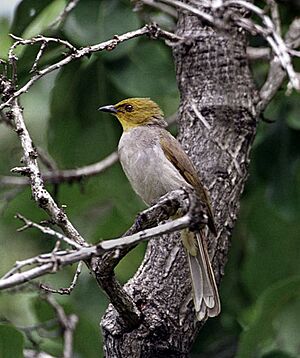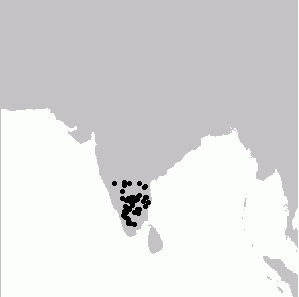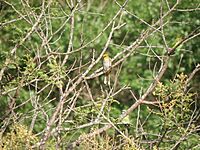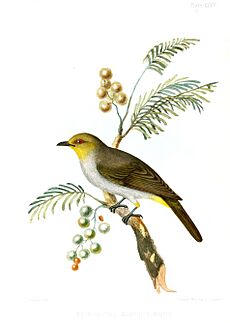Yellow-throated bulbul facts for kids
Quick facts for kids Yellow-throated bulbul |
|
|---|---|
 |
|
| Conservation status | |
| Scientific classification | |
 |
|
| Synonyms | |
|
The yellow-throated bulbul (Pycnonotus xantholaemus) is a small songbird that belongs to the bulbul family. These birds are special because they are endemic to southern India. This means they are found naturally only in that part of the world! They live on rocky hills covered with bushes, but their homes are sometimes threatened by mining for granite. It can look a bit like the white-browed bulbul, but the yellow-throated bulbul has bright yellow on its head, throat, and under its tail. Its calls sound very similar to the white-browed bulbul's calls.
Contents
About the Yellow-Throated Bulbul
This bulbul is not crested, meaning it doesn't have a feathery tuft on its head. Its back is olive-grey, and it has a bright yellow throat, yellow feathers under its tail, and yellow tips on its tail. Its head is plain, and its chest and belly have a greyish color.
The bird that looks most like it is the white-browed bulbul. However, the white-browed bulbul has a white stripe above its eye (called a supercilium) and does not have a yellow throat. Both male and female yellow-throated bulbuls look very similar.
Where They Live and Their Homes
Yellow-throated bulbuls live on rocky hills covered with bushes. You can find them mostly in the Eastern Ghats and central parts of India. They also live in some areas of the Western Ghats.
Their homes are spread out and often in small, separate groups. This makes these hilly areas very important for their protection. Many of these hill forests are in danger from granite mining, forest fires, and animals grazing. The yellow-throated bulbul has disappeared from many places where it used to live.
Some well-known places where they are found include the Nandi Hills, Horsley Hills, Gingee, Yercaud, and the Biligirirangans. They are also seen in parts of the Western Ghats, like the Anamalais. The northernmost place they are known to live is the Nallamala range.
Bulbul Behavior and Life
These birds are usually shy and like to stay hidden among the bushes. You might hear them before you see them! They make sudden, loud cackling calls, which sound a lot like the calls of the white-browed bulbul.
They eat insects and the berries from different kinds of bushes. Some of the plants they get food from include Lantana camara, Flueggea leucopyrus, Toddalia asiatica, Erythroxylon monogynum, Solanum indicum, Santalum album, Ziziphus, Ficus benghalensis, Ficus nervosa, Ficus montana, Canthium dicoccum, and Phyllanthus reticulata.
When it's very hot in the afternoon or during the dry season, they visit water pools. They go there to drink water and to take a bath.
Reproduction and Life Cycle
The yellow-throated bulbul's breeding season is from June to August. They build their nest in the fork of a small tree, which is where two branches meet.
The female bulbul lays two eggs. These eggs hatch after about 20 days. The baby birds, called chicks, then stay in the nest for about 13 more days before they are ready to fly out on their own.




